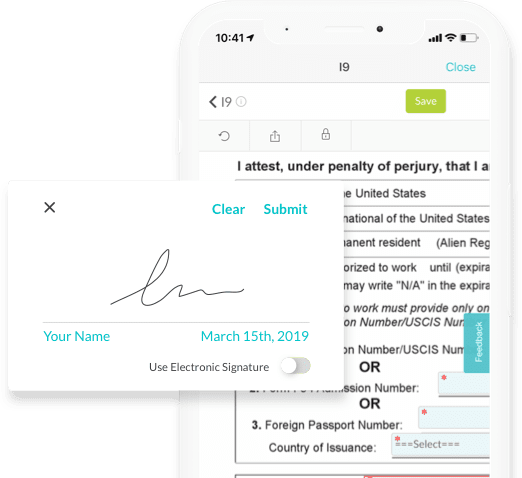Transforming Your Onboarding Presentation: Key Strategies for Engagement



 Cut onboarding time
by 60%—here's the
Ultimate Checklist
that helped do it.
Cut onboarding time
by 60%—here's the
Ultimate Checklist
that helped do it.

Make a memorable first impression on new hires by making your onboarding presentation exciting instead of dull. A corporate summary, core values, and expectations should all be included in the onboarding presentation to ensure that it is as effective as possible.
Statistics about your company's growth and performance can be powerful communication tools. Integrating these data points lends credibility to your presentation and illustrates just how great your company is. Icebreaker activities and interactive elements further enhance engagement, making the onboarding experience exceptional, educational, and enjoyable.
Understanding The Importance Of Onboarding Presentations
An effective onboarding presentation is crucial for making powerful first impressions, setting the stage for active engagement, and aligning new hires with the company's core values and objectives.
The Significance Of First Impressions
The new hire's initial perception of your company's work culture, values, and expectations will be shaped by your onboarding presentation. When you provide an engaging and well-organized presentation, you exude professionalism and a friendly vibe.
An effective onboarding presentation may ease new hires' anxieties and create a healthy work environment from the very beginning.
Setting The Tone For Employee Engagement
For new hires to feel more connected to the firm, it is important to make sure they fully grasp the mission, values, and code of conduct.
A presentation that helps people understand their jobs within the organization includes a summary of the organization and detailed descriptions of each department.
Highlighting opportunities for growth and development encourages new hires to fully commit to their roles and contributes to higher productivity and job satisfaction.
Aligning With Company Values And Objectives
Recruits must align with the objectives and core values of your business to perform consistently and behave ethically. An employee onboarding presentation should emphasize the organization's core principles, work culture, and policies and procedures.
It is important to go over the company's mission, ethical standards, and diversity programs with new hires to make sure everyone knows what the group is aiming for. By guaranteeing that workers behave in a manner that reflects the company's beliefs and goals, this alignment not only fosters unity but also increases the organization's overall integrity.
Photo by Nappy on Pexels
Assessing Current Onboarding Practices
To ensure your onboarding presentation evolves from mundane to memorable, evaluating your current practices is essential. Focus on pinpointing common pitfalls, gathering valuable feedback from new hires, and analyzing metrics like retention rates and satisfaction surveys.
Identifying Common Onboarding Pitfalls
Many onboarding programs can feel too broad or overly detailed. New hires often experience information overload in their first week, which can be overwhelming. Ensure your new hire presentation remains clear, focused, and engaging to avoid this issue.
Another pitfall can be the lack of a centralized learning hub, which is crucial for smooth onboarding. Remote employees especially need easy access to training materials and company information. Assess the comprehensiveness of the orientation process and whether it meets the specific needs of different departments.
Gathering Feedback From New Hires
Both during and after the onboarding process, issues that need improvement can be found through formal and informal questionnaires.
Encourage new hires to share their experiences during the first week and ask questions about clarity, engagement, and support. This feedback can help refine your onboarding presentation and processes. Creating an open line of communication helps new hires feel valued and listened to, which can foster a positive company culture.
Analyze Retention Rates And Employee Satisfaction
One common indicator of more serious problems is a high turnover rate with the onboarding process in the first year. Check if the onboarding initiatives match the job requirements established at the time of recruiting.
Check whether satisfaction surveys highlight recurring themes about the onboarding experience. Look specifically at the satisfaction levels of remote employees compared to on-site staff to identify if specific improvements are needed for different groups.
Use this data to guide your adjustments. Implementing changes based on this analysis can significantly enhance the onboarding experience.

Designing An Engaging Onboarding Presentation
To create an engaging onboarding presentation, consider crafting a compelling narrative, using visual aids effectively, and incorporating interactive elements. These steps will help your new hires feel welcome and informed, fostering integration into your company culture and mission.
Crafting A Compelling Narrative
Use storytelling to illustrate the organizational structure and team dynamics. Consider creating a roadmap that includes future goals and projects. This not only educates new hires but also inspires them to envision their growth within the company.
Use real-life examples to make abstract policies relatable. Highlight a typical day or share success stories of current employees. This approach will ensure trainees understand policies and guidelines in a meaningful context.
Using Visual Aids Effectively
Infographics, instructional videos, and graphs are examples of visual aids that improve comprehension and memory. To arrange your content rationally, start with a PowerPoint presentation or other comparable software. Focus on the important themes and bolster them with images to avoid clutter.
Include branding components like the company's logos and colors. This gives new hires a seamless experience while also reiterating your brand identity. To help them acclimatize to their new surroundings, use maps to give them a visual tour of the workplace.
Incorporating Interactive Elements For Engagement
Stimulate involvement through Q&A sessions or conversational group sessions. To get input in real-time, use digital tools such as live polls and questionnaires.
Incorporate interactive training modules that require active participation. This can include simulations or role-playing scenarios that mirror real job tasks. Interactive infographics and clickable maps can make navigating company policies and guidelines more engaging.
Implementing Innovative Techniques
Enhancing your onboarding presentation can significantly improve employee engagement and retention.
Gamifying The Onboarding Process
Using gamification techniques in your onboarding presentation can transform mundane tasks into interactive and enjoyable experiences. For instance, quizzes on the company’s dress code and hierarchy can enhance their knowledge while making learning fun.
Icebreaker activities and team-building games promote early bonding among new hires and their colleagues. Utilizing trackable QR codes, easily scanned with a QR code scanner provides instant access to resources, making the onboarding experience seamless and engaging.
Personalizing The Presentation For Different Job Roles
Highlight information pertinent to specific roles, such as department-specific resources and professional responsibilities. Market the company culture, including the team collaboration program and the internal chain of command to help new hires slot into their roles confidently.
Include personalized sections that detail role-specific expectations and employee benefits, ensuring each team member understands their compensation and how they fit into the company hierarchy. This personalized approach can greatly improve the transitioning phase for new hires.
Integrating Technology For Seamless Onboarding Experience
Leveraging modern technology improves the onboarding experience by providing a more interactive and engaging platform. Using software for virtual onboarding sessions can help remote hires feel connected. Creating a central learning hub where new hires can access resources and collaborate with team members can significantly speed up their integration.
Making use of a QR code generator facilitates self-paced learning, minimizes confusion, and improves access to onboarding resources. Including interactive components like online tests and instant feedback gives new hires a better understanding of their responsibilities and what the organization expects of them.
Photo by Tima Miroshnichenko on Pexels
Measuring Success And Continuous Improvement
To transform your onboarding presentation from mundane to memorable, measuring success through key metrics, regular feedback, and fostering a culture of continuous improvement is crucial.
Tracking Key Metrics For Onboarding Success
Key metrics to consider include time-to-productivity, which measures the speed at which a new hire becomes productive.
-
Monitoring employee retention rates helps you understand if new hires are sticking around, while employee satisfaction surveys provide insights into their experience.
-
Organizations can also use an employee scorecard to track individual performance, identifying areas for improvement.
Conducting Regular Feedback Surveys
Regularly conducted surveys, focusing on job satisfaction and employee well-being, provide valuable data. These surveys should be specific, asking about different stages of onboarding and the support provided.
Feedback should be logged and analyzed for trends. For instance, collected data's SWOT analysis (Strengths, Weaknesses, Opportunities, Threats) can spotlight areas requiring attention. This continuous feedback loop improves engagement and supports the organization in introducing necessary adjustments for better onboarding experiences.
Creating A Culture Of Continuous Learning And Improvement
Increasing the number of new personnel who actively participate in ongoing training sessions and development programs boosts output and effectiveness. Engagement and relevancy are guaranteed by routinely updating training materials in response to employee input.
Furthermore, encouraging an atmosphere that values open communication and regular feedback encourages development and growth, which raises staff retention and customer satisfaction levels.
Conclusion
You can significantly boost employee retention and satisfaction with some swift changes to your onboarding presentation. Make a boring procedure exciting and memorable by emphasizing engaging tactics and continuous improvement initiatives.
About Author:
This article is written by a marketing team member at HR Cloud. HR Cloud is a leading provider of proven HR solutions, including recruiting, onboarding, employee communications & engagement, and rewards & recognition. Our user-friendly software increases employee productivity, delivers time and cost savings, and minimizes compliance risk.

Utilize effective HR case studies from comparable businesses to demonstrate how better onboarding affects overall business success.
Create a thorough strategy that outlines the suggested modifications, related expenses, and anticipated results. Break down the budget to reflect both short- and long-term advantages.
Keep Reading
Night Shift, Float Pool, PRN: Onboarding Non-Traditional Nursing Schedules
Most nurse onboarding programs assume everyone works 9-to-5. Your carefully designed
Onboarding Home Health and Community Care Teams Who Never See the Main Office (The Tether Strategy)
You hire them on Monday. They see their first patient on Tuesday. And you might not see
Credential Tracking in Healthcare: How to Automate License Renewals and Stay Audit-Ready
A nurse shows up ready for her shift but her license expired yesterday. You scramble for
Like What You Hear?
We'd love to chat with you more about how HR Cloud® can support your business's HR needs. Book Your Free Demo

Build a Culture of Recognition. Boost Engagement. Guaranteed.
Workmates empowers employees to stay informed, connected, and appreciated—whether they’re on the front line, in the office, or remote. Recognition drives 12x higher engagement.Trusted by industry leaders in every sector




Cut Onboarding Costs by 60%.
Take the confusion and follow-ups out of onboarding with automated workflows, digital forms, and structured portals—so new hires ramp faster 3X quicker.Trusted by industry leaders in every sector







